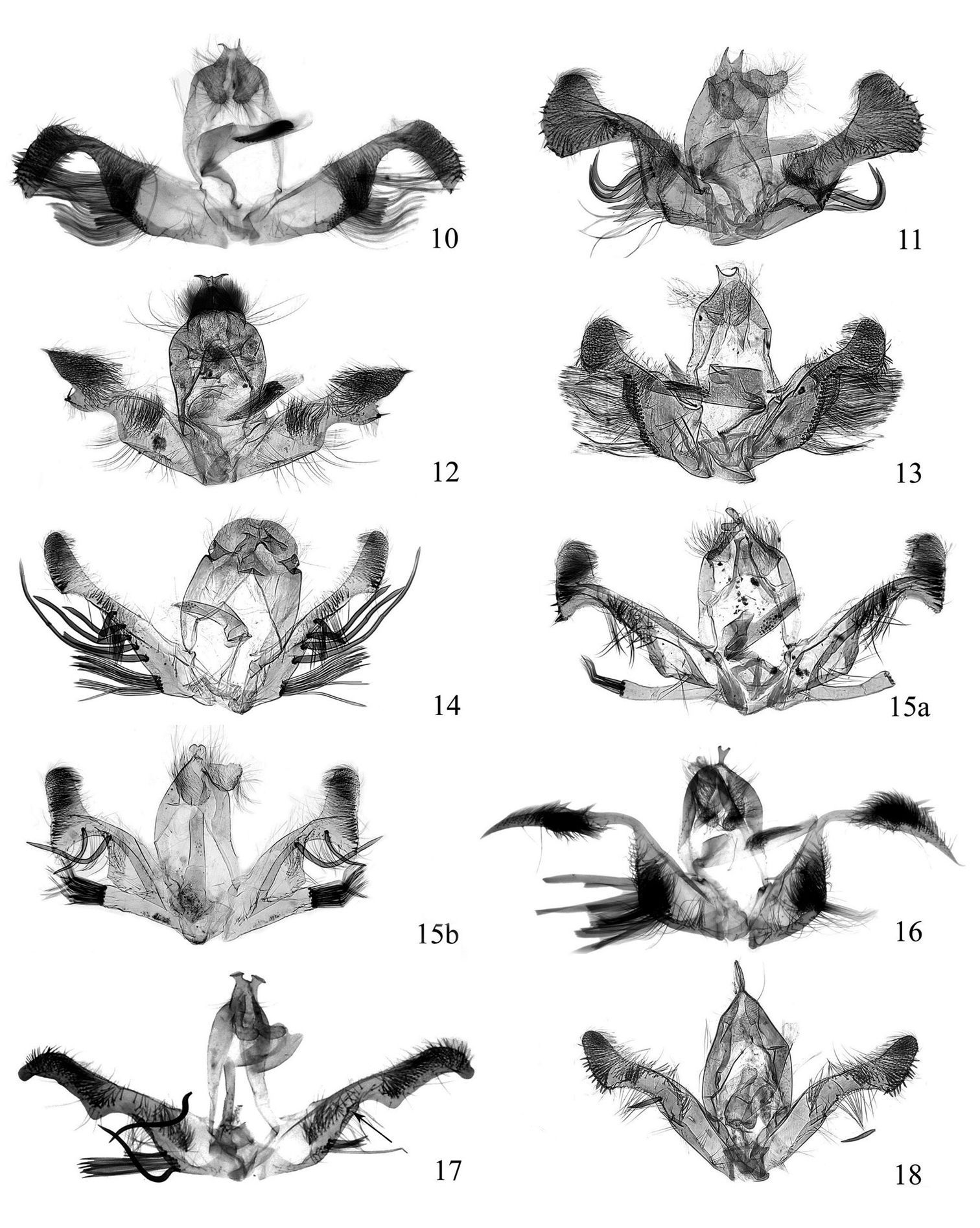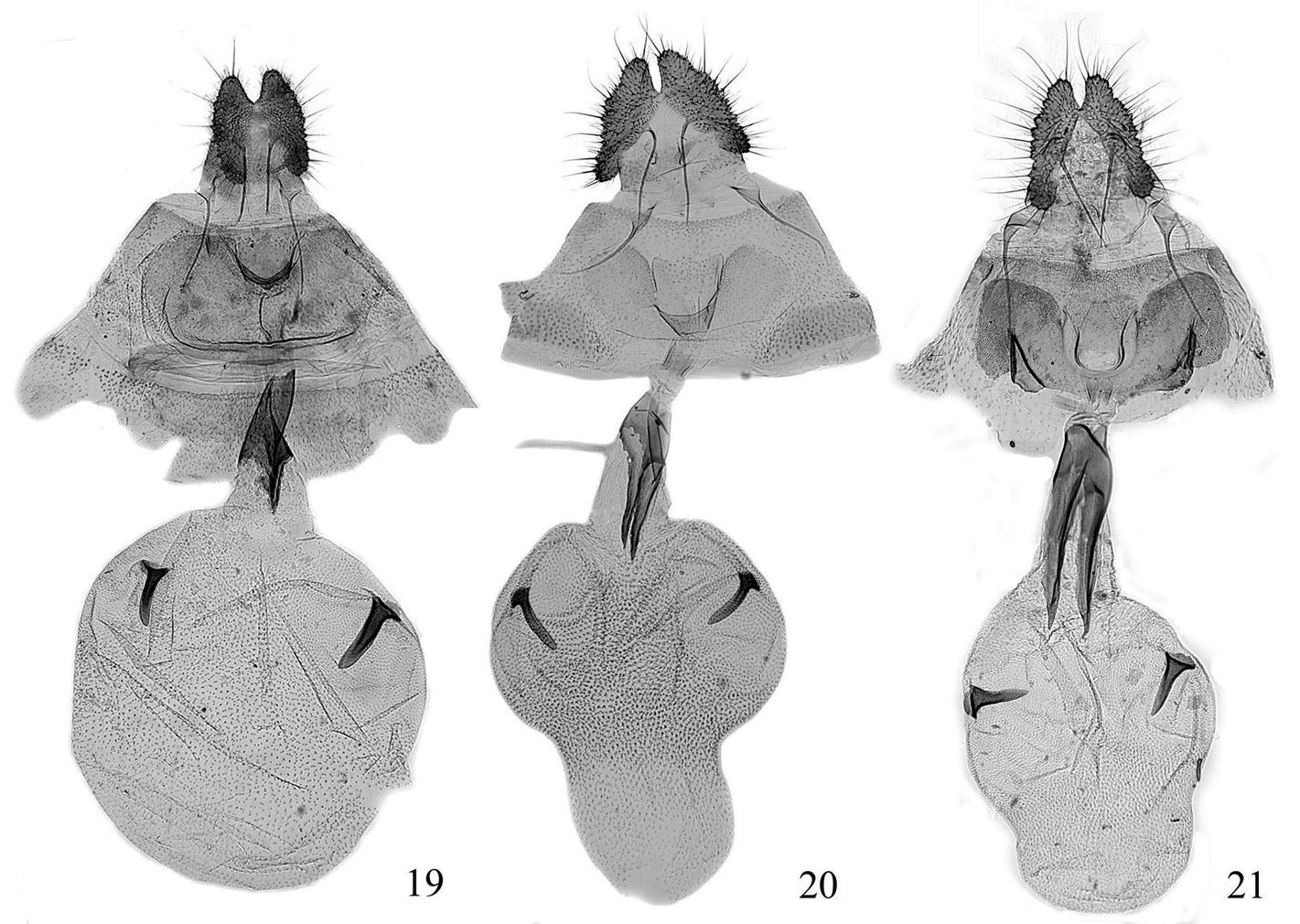(C) 2010 Aihuan Zhang. This is an open access article distributed under the terms of the Creative Commons Attribution License, which permits unrestricted use, distribution, and reproduction in any medium, provided the original author and source are credited.
For reference, use of the paginated PDF or printed version of this article is recommended.
Species of the genus Fibuloides Kuznetsov that occur in China are reviewed. Fibuloides trapezoidea, sp. n.is described as new; Fibuloides levatana (Kuznetsov) and Fibuloides modificana Kuznetsov are newly recorded for China; Acroclita nigrovenana Kuznetsov, syn. n. is considered as a synonym of Fibuloides corinthia(Meyrick); and Eucoenogenes elongata Zhang & Li and Eucoenogenes wuyiensis Zhang & Li are transferred to Fibuloides, resulting in two new combinations. A key to the nine Chinese species of Fibuloides is given.
Lepidoptera, Tortricidae, Fibuloides, new species, new combination, synonym, China
Fibuloideswas proposed by
Currently the genus includes 23 species distributed in the Palaearctic, Oriental and Australian regions (
This study is based on the examination of specimens
collected using light traps in the forests and mountains, mainly from
the southern part of China. The terminology for the forewing pattern
follows
Abbreviations
TL Type locality;
BMNH The Natural History Museum, London, UK;
ZMAS Zoological Institute, Russian Academy of Sciences, St. Petersburg (Leningrad), Russia;
NKUM Insects Collections, College of Life Sciences, Nankai University, Tianjin, China;
USNM National Museum of Natural History, Washington, D. C., USA.
Taxonomic accounts| 1 | Uncus blunt apically | 2 |
| – | Uncus pointed apically | 4 |
| 2 | Sacculus with a digitate process, neck of valva with two enlarged, flattened bristles | Fibuloides japonica |
| – | Sacculus without digitate process, neck of valva with one or more than three enlarged, flattened bristles | 3 |
| 3 | Uncus drooping, projected outward, socius upturned; neck of valva with five enlarged, flattened bristles on left side and four on right side, cucullus somewhat elliptic | Fibuloides elongata |
| – | Uncus not drooping, socius drooping, neck of valva with one enlarged, flattened bristle, cucullus somewhat trapezoidal | Fibuloides modificana |
| 4 | Neck of valva without enlarged, flattened bristles | 5 |
| – | Neck of valva with one or more enlarged, flattened bristles | 7 |
| 5 | Cucullus bipartite, nearly ovate, or nearly trapezoidal | 6 |
| – | Cucullus very long and narrow, with long point on end | Fibuloides levatana |
| 6 | Cucullus nearly trapezoidal, uncus with tips straight and parallel | Fibuloides trapezoidea |
| – | Cucullus bipartite, nearly ovate, uncus with tips bent outward | Fibuloides corinthia |
| 7 | Socius triangular, angle of sacculus indistinct | Fibuloides wuyiensis |
| – | Socius lobe-shaped, angle of sacculus obtuse | 8 |
| 8 | Cucullus nearly triangular; socius broad and short, about twice as long as wide | Fibuloides aestuosa |
| – | Cucullus ovate; socius slender, about three times as long as wide | Fibuloides cyanopsis |
urn:lsid:zoobank.org:act:EA201525-B594-47F4-A928-6C254A1B37C6
Figs 1, 10Holotype ♂ – China, Guizhou Province: Chishui (28°34'N, 105°42'E), 390 m, 30.V.2000, coll. Yanli Du, genitalia slide no. YHL04481; Paratype – 1 ♂, 27.V.2000, other same data as for holotype, genitalia slide No. ZAH10019.
This species is similar to Fibuloides cyanopsis(Meyrick, 1912) in the shape of uncus and socius, but can be distinguished by the trapezioidal cucullus and the absence of the enlarged, flattened bristles on the neck of valva. In Fibuloides cyanopsis the cucullus is ovate and the neck of valva has two or more short enlarged, flattened bristles on its ventral side.
Adult (Fig. 1). Forewing length 6.5 mm. Head: Vertex with gray scales; frons white. Antenna light brown. Labial palpus slender, gray intermixed with brown, third segment porrect. Thorax: Thorax and tegula gray intermixed with light brown. Forewing elongate triangular, with ground color dark gray; basal patch extending from costal 1/4 to 1/3 of dorsum, protrudent in middle on outer side; median fascia short and broad, extending from costal half, terminated at end of cell; ocellus nearly quadrate, containing some short brown striae; apex brown, protrudent; termen slightly concave below apex, bordered by brown scales; costa with nine pairs of strigulae from base to apex, each pair of strigulae with a short brown stria extending obliquely; first to fourth pairs between base of wing and the point where Sc meets costa, broad brown patch lying between second and third pairs; fifth and sixth pairs between Sc and R1; distal three pairs distributed between pairs of veins R1–R2, R2–R3, R3–R4 respectively, separated from each other by dark brown scales; cilia gray mixed with brown. Hindwing and cilia gray. Legs gray, tarsi with brown rings.
Adults of Fibuloidesspp. 1 Fibuloides trapezoidea Zhang & Li, sp. n., ♂ 2 Fibuloides aestuosa (Meyrick), ♂ 3 Fibuloides corinthia (Meyrick), ♂ 4 Fibuloides cyanopsis (Meyrick), ♀ 5 Fibuloides elongata (Zhang & Li), ♂ 6 Fibuloides japonica (Kawabe), ♂ 7 Fibuloides levatana (Kuznetsov), ♂ 8 Fibuloides modificana Kuznetsov, ♂ 9 Fibuloides wuyiensis (Zhang & Li), ♂.
Male genitalia of Fibuloidesspp. 10 Fibuloides trapezoidea Zhang & Li, sp. n., slide No. YHL04481 11 Fibuloides aestuosa (Meyrick), slide No. ZAH03603 12 Fibuloides corinthia (Meyrick), slide No. ZAH04036 13 Fibuloides cyanopsis (Meyrick), slide No. ZAH03758 14 Fibuloides elongata (Zhang & Li), slide No. ZAH03725 15a–15b Fibuloides japonica (Kawabe), slide Nos. a: ZAH03173, b: ZAH04296 16 Fibuloides levatana (Kuznetsov), slide No. ZAH04299 17 Fibuloides modificana Kuznetsov, slide No. LJM04401 18 Fibuloides wuyiensis (Zhang & Li), slide No. ZAH04215.
Male genitalia (Fig. 10). Uncus bifurcated from near base, produced into two slender, parallel and widely separated tips. Socius broad and short, about twice as long as wide, drooping, hairy, with round end. Valva broad at base; neck distinct, without enlarged, flattened bristles; sacculus about twice size of cucullus, with a line of flattened long bristles; cucullus trapezoidal, hairy, with marginal spines. Anellus closely surrounding basal 1/3 of aedeagus; aedeagus long tubular, cornuti consisting of a bunch of curved spines.
Unknown.
China (Guizhou).
The specific name is derived from Latin trapezoideus (= trapeziform), referring to the shape of the cucullus.
Figs 2, 11, 19
China, Sichuan Province: 1 ♀, Baoxing County, 1600 m, 3.VIII.2004, coll. Yingdang Ren. Zhejiang Province: 2 ♂♂, 3 ♀♀, Mt. Tianmu, 350–1500 m, 18~20.VIII.1999, coll. Houhun Li et al. Hubei Province: 2 ♂♂, 3 ♀♀, Hefeng County, 1260 m, 15–16.VII.1999, coll. Houhun Li et al. Henan Province: 1 ♀, Song County, 1580 m, 23.VII.2002, coll. Xinpu Wang.
Fagaceae: Castanea mollissima Blume and Castanea cranata Sieb. et Zucc. (
China (Anhui, Henan, Hubei, Guangxi, Liaoning, Sichuan, Yunnan, Zhejiang), Korea, Japan, India, Bengal.
The number of thick flattened bristles below the neck of the valva in the male genitalia is variable (two or more).
Figs 3, 12
China, Yunnan Province: 1 ♂, Yuanjiang County, 710 m, 28.IV.1995, coll. Guangyun Yan.
Sapindaceae: Litchi chinensis Sonn. (Kuznetsov 2001).
China (Yunnan, Taiwan); Sri Lanka; India.
The male uncus is produced into two sharp, outwardly bent tips, and the cucullus is nearly elliptic, ending in a spine, with a ventral process bearing a short distal spine.
Female genitalia of Fibuloides spp. 19 Fibuloides aestuosa (Meyrick), slide No. ZAH03604 20 Fibuloides cyanopsis (Meyrick), slide No. ZAH03757 21 Fibuloides japonica (Kawabe), slide No. ZAH03645.
Figs 4, 13, 20
China, Guangxi Zhuangzu Autonomous Region: 1♂, 3 ♀♀, Shangsi County, 260–770 m, 1–3.IV.2002, coll. Shulian Hao and Huaijun Xue; 1 ♂, 3 ♀♀, Mt. Maoer, 550–1100 m, 19–20.IV.2002, coll. Shulian Hao and Huaijun Xue. Guangdong Province: 1 ♀, Lianzhou, 650 m, 23.VI.2004, coll. Dandan Zhang. Guizhou Province: 1 ♀, Jiangkou County, 1700 m, 29.VII.2001, coll. Houhun Li and Xinpu Wang.
China (Guangdong, Guangxi, Guizhou), Japan, Vietnam, Indonesia, India.
The cucullus of this species is ovate, and the neck of valva has two or three short enlarged, flattened bristles.
Figs 5, 14
Holotype ♂, China, Yunnan Province: Weishan County, 2200 m, 20.VII.2001, coll. Houhun Li and Xinpu Wang, genitalia slide no. ZAH03725.
China (Yunnan).
This species can be easily distinguished from its congeners by the drooping uncus with a blunt apex, and the narrow valva with the neck bearing five long, flattened flagellate bristles on the left side and four on the right side.
China, Shaanxi Province: 2♂♂, Ningshan County, 880 m, 17.VI.1987, coll. Houhun Li; 9 ♂♂, 3 ♀♀, Yangxian County, 600–680 m, 17–18.IV.1995, coll. Hongjian Wang. Henan Province: 3 ♂♂, Luoshan County, 350 m, 2.V.2000, coll. Haili Yu; 2 ♂♂, Xinyang City, 700 m, 11.VII.1997, coll. Houhun Li; 1♂, Tongbai County, 300 m, 11.IX.2001, coll. Houhun Li and Ole Karsholt; 2 ♂♂, Chishui County, Guizhou Province, 240 m, 21–22.IX.2000, coll. Haili Yu. Guizhou Province: 1 ♂, Xishui County, 500 m, 25.IX.2000, coll. Haili Yu; 5 ♂♂, 1 ♀, Daozhen County, 1300 m, 20.VIII.2004, coll. Yunli Xiao. Zhejiang Province: 1 ♂, Mt. Tianmu, 650 m, 20.VIII.1999, coll. Houhun Li. Hunan Province: 1 ♀, Zhangjiajie, 650 m, 7.VIII.2001, coll. Houhun Li and Xinpu Wang. Fujian Province: 1 ♂, Nanping, 850 m, 23.IX.2002, coll. Xinpu Wang; 1 ♂, Jianning County, 350 m, 25.IX.2002, coll. Xinpu Wang. Hubei Province: 1 ♂, Hefeng County, 1260 m, 16.VII.1999, coll. Houhun Li.
China (Zhejiang, Anhui, Fujian, Henan, Hubei, Hunan, Sichuan, Guizhou, Shaanxi, Taiwan), Korea, Japan.
This species is distinguished by the digitate process on the sacculus in the male genitalia bearing either dense tufted bristles or five enlarged, flattened bristles distally.
In the examined specimens, the appearance of the adults and the female geniatlia are identical, but the male genitalia have two types (Figs 15a and 15b): in figure 15a, the relatively elongate uncus looks like a pair of long ears of a rabbit, and the slender digitate process of the sacculus bears five enlarged, flattened bristles distally; in figure 15b, the short uncus is emarginated posteriorly and somewhat heart-shaped, and the digitate process of the sacculus is relatively broad and bears dense tufted bristles distally. The two types of male genitlia might represent two different species, but in this paper we treat these differences as individual variations. We may confirm whether they are two species or just one species after a geographic analysis, which can be done when more specimens are available.
Figs 7, 16
China, Zhejiang Province: 1 ♂, Mt. Tianmu, 350 m, 20.VIII.1999, coll. Houhun Li et al. Fujian Province: 1 ♂, Yongtai County, 550 m, 18.IX.2002, coll. Xinpu Wang.
China (Zhejiang, Fujian), Vietnam.
This species can be easily distinguished by its Y-shaped uncus and the slender distally attenuate cucullus. It is new for China.
Fig. 8, 17
China, Guangxi Zhuangzu Autonomous Region: 1 ♂, Leye County, 665 m, 24.VII.2004, coll. Jiasheng Xu.
China (Guangxi), Vietnam.
The uncus of this species is broad and distally bifurcate, the valva has a long, sinuate, flattened bristle on the neck, and the cucullus is elongatesubrectangular and distally downcurved. In figure 17 the long flattened bristle is off the inserted hole which is located on the ventral side of the neck instead of on the angle of the sacculus (see arrow in fig. 17).It is new for China.
Figs 9, 18
Holotype ♂, China, Fujian Province: Mt. Wuyi, 1000 m, 26.V.2004, coll. Haili Yu, genitalia slide no. ZAH04215; Paratype: 1 ♂, same data as for holotype.
China (Fujian).
This species is distinguishable from its congeners by the following characters: the uncus tips are slender and closely parallel; the socius is laterally triangular; and the neck of the valva has a short flattened bristle.
The authors are grateful to Dr. N. Pinkaew, Department of Entomology, Kasetsart University, Thailand and Dr. Y. Nasu, Osaka Prefectural Agricultural, Forestry Research Center, Japan for providing us with references and good advice; to Dr. John W. Brown (Systematic Entomology Lab, National Museum of Natural History, Washington, DC) and Dr. Marianne Horak (CSIRO Ecosystem Sciences, Canberra) for reviewing the manuscript and giving valuable suggestions. The research was supported by the National Natural Science Foundation of China (No. J0930005) and Beijing Nova Program (No. 2008B23).









